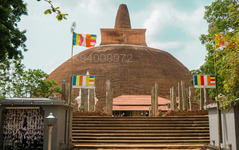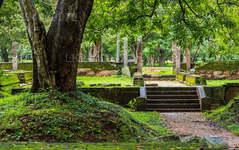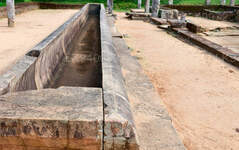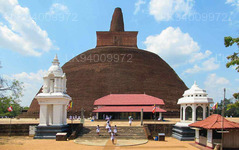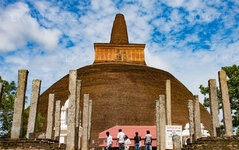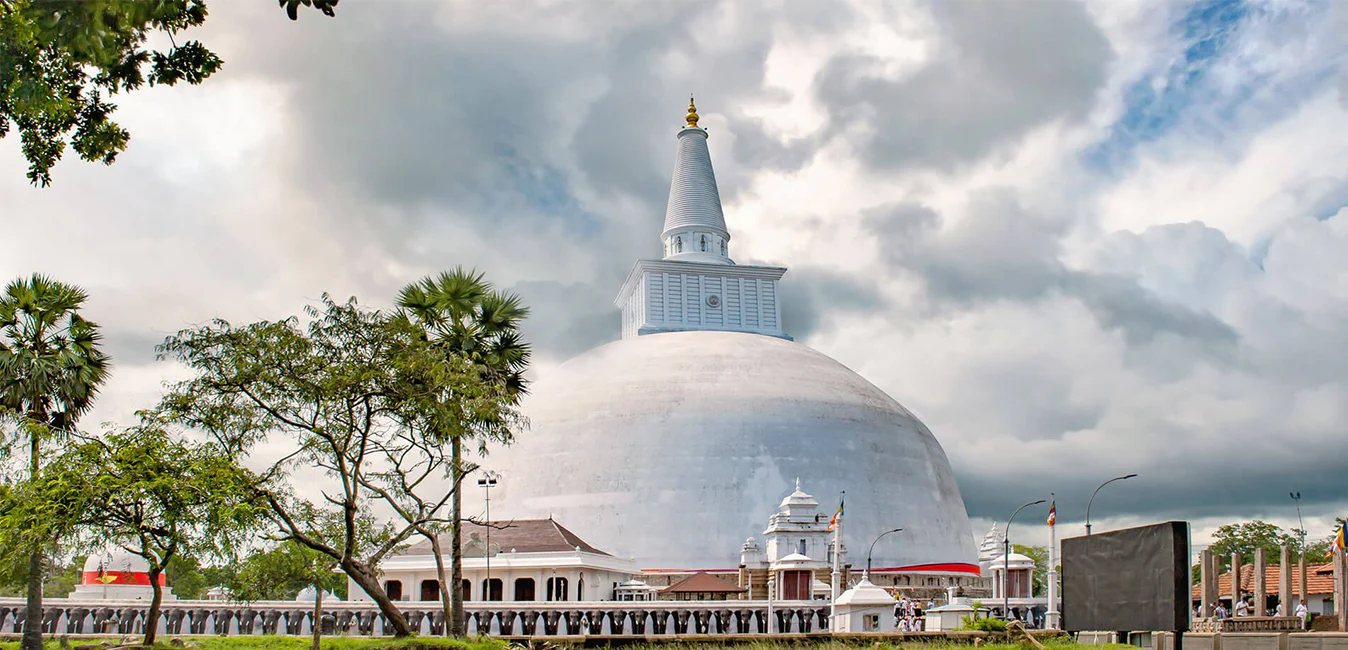
Anuradhapura City
Anuradhapura is belongs to the North Central Province in to Sri Lanka. Anuradhapura is one of the ancient capitals of Sri Lanka, famous for its well-preserved ruins of ancient Lankan civilization. The city, now a UNESCO World Heritage Site, lies 205 km north of the current capital Colombo in Sri Lanka.
Abhayagiri Monastery
Abhayagiri Monastery in Sri Lanka, Anuradhapura established in the second century B.C., by King Valagamabau, during its glorious days, was not only complex of monastic buildings but also a great seat of learning. Unlike orthodox Mahavihara monastery, Abhayagiri Monastery accommodated the intellectual discussion on various schools of Buddhist thought in addition to Theravada Buddhism, considered as the pure words of Buddha. The center of attraction of the monastery was Abhayagiri stupa, the second tallest stupa at Anuradhapura, also built by King Valagambahu (89-77 BC).
In the 5th century, the Chinese monk Fa-Hsien visited Abhayagiri, the flourishing center of Buddhist studies. The monk lived 2 years at Abhayagiri Monastery copying Buddhist texts and took all copies to China. Fa-Hsien also made written records of his life and times at Abhayagiri Monastery. In his memoirs, he wrote about the Tooth Relic, monasteries, stupas, and statues of Sri Lanka.
The new museum at Abhayagiri Monastery, a source of valuable information to the tourists, was established in memory of Fa-Hsien to house the treasures discovered during the excavations at Abhayagiri Monastery. A large horde of artifacts was unearthed at the monastery during the recent excavations: ornaments and jewelry made of gold and studded with gems and crystals; coins belonging to the pre-Christian era; metal objects; molds and crucibles used in their manufacture; ceramics; pottery; glass; tiles; sculptures etc.
Abhayagiri Monastery, Highlights
Lankarama Dagoba
Lankarama Monastery is located to the south of the Abhayagiri Monastery and east of the Bulankulama man-made tank. Lankarama Dagoba, known as Mani Somarama meaning “the monastery of Soma” in Sinhalese, was built by King Valagambahu in celebration of the return of Somadevi, who was captured and taken to southern India by the marauding Dravidian Army. Having regained his kingdom from the Dravidian invaders, the king secured the release of his queen too. It is believed that Lankarama was the nunnery of the Abhayagiri Monastery.
Lankarama Dagoba is another vatadage (circular relic house) in Sri Lanka: in its days of glory, Lankarama had 88 stone columns, in three concentric circles, surrounding the dagoba that held up a circular roof. Today only a few of the carved stone pillars can be seen around the renovated dagoba. The renovated dagoba measuring 38 feet in diameter is set up on a platform 10feet in height and 132 feet in diameter. Four flights of steps from the cardinal directions take the devotees to the platform 10 feet above the ground level. The four vahalkadas (front entrances doorways) no longer exist. Among the ruins are few damaged Buddha statues and stone tubs for washing feet before entering the sacred terrace, the platform.
Eth-Pokuna
Eth-Pokuna (Sinhala: Elephant Pond), located south-west of the Abhayagiri stupa was built during the third century A.C. A flight of steps from each of the four sides leads down to the rectangular pond measuring 150 meters in length and 50 meters in width and 10 meters in depth. Its cistern sluice (bisokotuwa) and conduit that supplied water to the refectory present another instance of testimony to the ancient hydrology of Sri Lanka. Eth-Pokuna is believed to be the largest man-made pond built in the ancient era of Sri Lanka.
Pancavasa or the Five Residences
A group of 5 buildings set in a rectangular block enclosed by a wall has a layout of the roll of dice resulting in 5: four identical buildings at the four corners and a similar yet larger building in the center. The lotus pedestal at the center of the building at the center suggests that it once housed a Buddha statue. In turn, the existence of a Buddha statue suggests the building was an image house. The main attraction of the building is a moonstone.
Moonstones, the Doormats
Moonstone that serves as a doormat at ancient buildings of Sri Lanka, is a work of art. At Abhayagiri Monastery two exquisitely carved moonstones are discovered: one is at Mahasen’s palace also known as Pancavasa building; the other is at Queen’s Palace, just a short distance away. The stone carving on the semi-circular doormat is given several interpretations by the scholars. Of these Prof. Senerat Paranavitana’s interpretations is particularly noteworthy.
The outer motif represents the world on fire that symbolizes desire. The next ring of animals depicts the four states of birth, disease, aging, and death. Going beyond these sorrows on your path of emancipation there is the creeper and leaves that symbolize the life force. When you surpass this craving you reach the swan representing purification. And the lotus at the center represents Brahma worlds.”
The format of the cravings at various cultural attractions of Sri Lanka isn’t the same: Moonstones at Polonnaruwa is carved also with the image of a bull among other symbols. However, in any event, seeing a Moonstone is witnessing a masterpiece of sculpture.
Ratnaprasada
Abhayagiri Monastery’s largest building is Ratnaprasada also called Uposathagara of the resident monks. First built by King Kanitthatissa in the second century, it was later enlarged by King Mahinda the second who added several stories and had a golden statue of Buddha erected in it. The Dravidian invasion in the ninth century put the building to fire and sword. The present preserved ruins, monolithic pillars on a stone platform, date to 7-8 centuries while the recent excavation unearthed the ruins of the second-century foundation of the Ratnaprasada.
Among the preserved ruins is a guard stone, one of the two gravestones that were originally at Ratnaprasada. It is one of the finest works of art that belongs to the eighth century. The figure of a god-king therein is sheltered by an image of five hooded cobra Naga king. On both hands of the god-king image are vessels symbolizing prosperity: in the left hand is Pot of Plenty (purnaghata); in his right hand is a bunch of flowers representing Prosperity. At his feet is an image of a dwarf (bahirave) figure.
The Guard Stone
The Guard Stone at the inner entrance. Among the preserved ruins is a guard stone, one of the two gravestones that were originally at Ratnaprasada. This is considered the best examples of such carvings in the Anuradhapura Era.
The Refectory – Dana Sala
The large trough cut in a stone in the shape of a boat used to serve rice to about 5000 monks at the monastery. The smaller trough alongside is believed to be for gruel. Since the Buddhist monks were disciplined to have solid food only before noon, serving 5000 resident monks at the monastery could have been made easier by the shape of the vessel: monks on either side of the boat could themselves at a pace, in modern buffet style.
Underground conduits had supplied water at the entrance of the refectory for the monks to have their feet washed. The stone tablet at the eastern section of the refectory is a replica of the stone tablet that was used for measuring the movement of the sun. The original stone tablet was shifted to Abhayagiri museum.
Abhayagiri Stupa
Abhayagiri Stupa rising to a height of 75 meters is of a diameter of 106 meters. The outer square terrace is strewn with sand while the inner terrace is paved with stone. The premises of the Abhayagiri stupa encompassing the building and two terraces spread over an area of about 6 hectares. The four ponds at the four entrances set in the four cardinal directions were designed to gather the water falling onto the terrace.
The Abhayagiri stupa built by King Valagambahu in the second century B.C, was enlarged by King Gajabahu also in the second century B.C. and renovated by King Parakramabahu the Great in the 12th century. Abhayagiri stupa’s four vahalkadas or the front pieces in the four cardinal directions at the base of the stupa are set facing the gateways of the square terrace.
Twin Ponds
The twin ponds, exquisite specimen of landscape architecture was belived to have been constructed during the reign of King Aggabodhi the first in the sixth century for the use of resident monks at Abhayagiri Monastery. Both ponds are same in breadth, i.e. 51 feet. The larger pond measures 132ft and the smaller pond measures 91ft in length. A cistern sluice located at the far end of one of the ponds supply water to the twin ponds. The channeled water pours into the pond through a stone cut spout. The perimeters of the twin ponds are molded in stone. Each pond has two flights of steps that lead down from the ground level into the pond from both ends. Two pots of plenty (purnaghata) sit on the pedestal on either side of flight of steps in each pond.
About Anuradhapura District
Anuradhapura is belongs to the North Central Province in to Sri Lanka. Anuradhapura is one of the ancient capitals of Sri Lanka, famous for its well-preserved ruins of ancient Lankan civilization. The city, now a UNESCO World Heritage Site, lies 205 km north of the current capital Colombo in Sri Lanka.
In the sacred city of Anuradhapura and in the vicinity are a large number of ruins. The ruins consist of three classes of buildings, dagobas, monastic buildings, and pokuna (ponds). The city had some of the most complex irrigation systems of the ancient world, situated in the dry zone of the country the administration built many tanks to irrigate the land. Most of the civilians are Sinhala, while Tamils and Sri Lankan Moors live in the district.
About North Central Province
North Central Province which is the largest province in the country covered 16% of total country's land area. North Central Province consist two districts called Polonnaruwa and Anuradhapure. Anuradhapura is the largest district in Sri Lanka. Its area is 7,128 km².
North Central Province has numerous potentials for Investors to start their Businesses, especially Agriculture, agro based industries and Livestock sectors. More than 65% of North Central Province's people depend on basic Agriculture and agro base industries. NCP also called "Wew Bendi Rajje" because there are more than 3,000 medium and large scale tanks situated in the province. Sri maha bodiya, Ruwanweli seya, Thuparama dageba, Abayagiri Monastry, Polonnaruwa Rankot wehera, Lankathilake are scared

